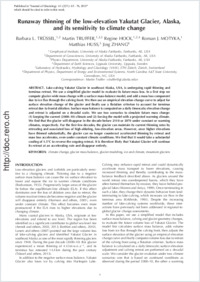Runaway thinning of the low-elevation Yakutat Glacier, Alaska, and its sensitivity to climate change
- Trüssel, Barbara L. Geophysical Institute, University of Alaska Fairbanks, AK, USA
- Truffer, Martin Geophysical Institute, University of Alaska Fairbanks, AK, USA - Physics Department, University of Alaska Fairbanks, AK, USA - Laboratory of Hydraulics, Hydrology and Glaciology (VAW), ETH Zürich, Switzerland
- Hock, Regine Geophysical Institute, University of Alaska Fairbanks, AK, USA - Department of Geosciences, University of Alaska Fairbanks, AK, USA - Department of Earth Sciences, Uppsala University, Sweden
- Motyka, Roman J. Geophysical Institute, University of Alaska Fairbanks, AK, USA
- Huss, Matthias Laboratory of Hydraulics, Hydrology and Glaciology (VAW), ETH Zürich, Switzerland
- Zhang, Jing Department of Physics, Department of Energy and Environmental Systems, North Carolina AT State University, Greensboro, NC, USA
-
13.10.2014
Published in:
- Journal of Glaciology. - 2015, vol. 61, no. 225, p. 65 - 75
English
Lake-calving Yakutat Glacier in southeast Alaska, USA, is undergoing rapid thinning and terminus retreat. We use a simplified glacier model to evaluate its future mass loss. In a first step we compute glacier-wide mass change with a surface mass-balance model, and add a mass loss component due to ice flux through the calving front. We then use an empirical elevation change curve to adjust for surface elevation change of the glacier and finally use a flotation criterion to account for terminus retreat due to frontal ablation. Surface mass balance is computed on a daily timescale; elevation change and retreat is adjusted on a decadal scale. We use two scenarios to simulate future mass change: (1) keeping the current (2000–10) climate and (2) forcing the model with a projected warming climate. We find that the glacier will disappear in the decade before 2110 or 2070 under constant or warming climates, respectively. For the first few decades, the glacier can maintain its current thinning rates by retreating and associated loss of high-ablating, low-elevation areas. However, once higher elevations have thinned substantially, the glacier can no longer counteract accelerated thinning by retreat and mass loss accelerates, even under constant climate conditions. We find that it would take a substantial cooling of 1.5°C to reverse the ongoing retreat. It is therefore likely that Yakutat Glacier will continue its retreat at an accelerating rate and disappear entirely.
- Faculty
- Faculté des sciences et de médecine
- Department
- Département de Géosciences
- Language
-
- English
- Classification
- Hydrology
- License
-
License undefined
- Identifiers
-
- RERO DOC 234307
- DOI 10.3189/2015JoG14J125
- Persistent URL
- https://folia.unifr.ch/unifr/documents/304310
Statistics
Document views: 117
File downloads:
- pdf: 147
